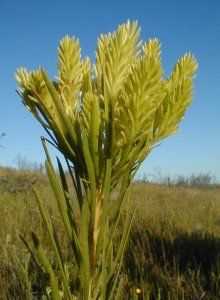
Home
Mission
Overview of Project
Project Staff
Sponsors
Achievements
Checking, Illustrations
Upcoming Activities
Id and Species Lists
Protea Information
Protea Gallery
Growing Proteas
Interim Dist. Maps
Publications
Afrikaanse Inligting
![]()
Featherbushes - Aulax
Channel-Leaf Featherbush - Aulax cancellata
| Female | Male | ||
 |
 |
Habit: Erect shrub to 2.5m
tall, single stem Fire survival: Killed, only seeds survive Sexual system: Flowers of one sex only, sexes on separate plants Flowers: November - February Pollinator: Unknown, probably insects Fruit: Stored in "cups" on plant, released after fire. Seed dispersal: Wind Seed storage: In "cups" on plant Rarity Status: Not threatened, often in dense stands Habitat: Sandstone soils, 0-1200m. Distribution: Cape Peninsula and Hottentots-Holland Mountains to Langeberg and Kouga Mountains, Swartberg and Kammanassie Mountains |
Needle-Leaf Featherbush - Aulax pallasia
| Female | Male | ||
 |
 |
Habit: Erect sparsely
branched shrub to 3m tall Fire survival: Resprouts from underground bole Sexual system: Flowers of one sex only, sexes on separate plants Flowers: January - April Pollinator: Unknown, probably insects Fruit: Stored in "cups" on plant, released after fire. Seed dispersal: Wind Seed storage: In "cups" on plant for a short time only Rarity Status: Not threatened, isolated clumps of scattered plants Habitat: Montane, sandstone soils, 800-2000m. Distribution: Piketberg, Koue Bokkeveld to Hottentots-Hollanda nd Groenland Mountains to central Langeberg and Riviersonderend Mountains |
Broad-Leaf Featherbush - Aulax umbellata
| Female | Male | ||
 |
 |
Habit: Erect shrub to 2.5m
tall, single stem Fire survival: Killed, only seeds survive Sexual system: Flowers of one sex only, sexes on separate plants Flowers: November - February Pollinator: Unknown, probably insects Fruit: Stored in "cups" on plant, released after fire. Seed dispersal: Wind Seed storage: In "cups" on plant Rarity Status: Not threatened, often in dense stands Habitat: Sandy soils, 0-500m. Distribution: Coastal flats, Kogelberg to Mossel Bay |
Back Featherbush Gallery